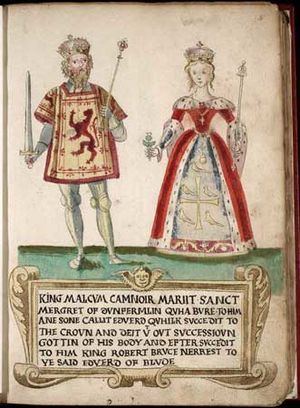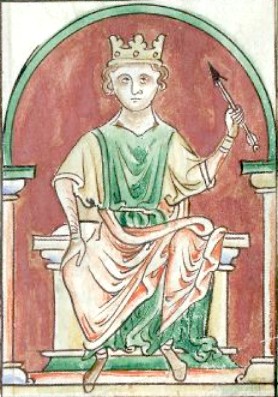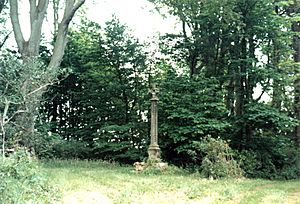Malcolm III of Scotland facts for kids
Quick facts for kids Malcolm III |
|
|---|---|
| King of Scots | |
| Reign | 17 March 1058 – 13 November 1093 |
| Coronation | 25 April 1058? Scone, Perth and Kinross |
| Predecessor | Lulach |
| Successor | Donald III |
| Died | November 13, 1093 Alnmouth, Northumberland, England |
| Burial | Tynemouth Castle and Priory, then in Dunfermline Abbey |
| Spouse | |
| Issue more... |
|
| House | Dunkeld |
| Father | Duncan I of Scotland |
| Mother | Suthen |
Malcolm III (Medieval Gaelic: Máel Coluim mac Donnchada; Scottish Gaelic: Maol Chaluim mac Dhonnchaidh; died 13 November 1093) was King of Scotland from 1058 to 1093. He was later nicknamed "Canmore", which means "big head" or "great chief" in Gaelic. Malcolm ruled for 35 years, and his time as king came before a period known as the Scoto-Norman age. He was the grandfather of important figures in English history, like Empress Matilda.
Malcolm's kingdom was not as big as modern Scotland. Many islands and northern lands were controlled by Scandinavians. South of the Firth of Forth, there were other small kingdoms. During his reign, Malcolm III attacked English territory at least five times. One of his main achievements was making sure his family would rule Scotland for a long time. His second wife, Margaret, became a saint later on.
Contents
Malcolm's Early Life
Malcolm's father, Duncan I, became king in 1034. Duncan I was killed in battle by Macbeth in 1040. Malcolm and his brother Donald were likely children at this time.
After his father's death, Malcolm was sent away for his safety. Some stories say he went to England. He might have stayed at the court of Edward the Confessor, the King of England. Other stories suggest he went to Thorfinn Sigurdsson, an Earl in Orkney.
In 1057, Macbeth was killed by Malcolm in Lumphanan, Aberdeenshire. Macbeth was followed by his stepson, Lulach, who became king. However, Malcolm killed Lulach in 1058. After this, Malcolm became the new King of Scotland. He was likely crowned on April 25, 1058.
Becoming King and First Marriage
When Malcolm became king, he might have become engaged to Margaret, a relative of the English King Edward. This could have happened when he visited England in 1059.
Malcolm married Ingibiorg Finnsdottir, who was the widow of Thorfinn Sigurdsson. Ingibiorg was the daughter of Finn Arnesson. They had a son named Duncan, who later became king. This marriage helped Malcolm have good relationships in the north and west of Scotland. He also had another son, Domnall, but we don't know who his mother was.
Malcolm gave shelter to Tostig Godwinson when he was forced out of Northumbria in 1065. In 1068, Malcolm welcomed English exiles who were running away from William of Normandy. Among them were Agatha and her children, Edgar Ætheling and his sisters Margaret and Cristina.
Marriage to Margaret
In 1069, the English exiles went back to England to join a rebellion. Malcolm decided to go to war and led his army south. He met Edgar and his family again. They were invited to return to Scotland with him. By the end of 1070, Malcolm married Edgar's sister, Margaret.
Malcolm and Margaret had eight children: six sons and two daughters. They gave their sons names that were popular with English royalty. These names included Edward, Edmund, Ethelred, and Edgar. They also named two sons Alexander and David. Their daughters were Edith (who married Henry I of England) and Mary.
In 1072, William the Conqueror came north with his army. Malcolm met William and agreed to be his "man," meaning he accepted William as his overlord. He also gave his eldest son, Duncan, as a hostage. This agreement was meant to bring peace. However, Malcolm continued to raid Northumbria.
Malcolm and William Rufus
When William Rufus became King of England, Malcolm did not get involved in the rebellions that followed. In 1091, William Rufus took Edgar Ætheling's lands in England. Edgar then fled to Scotland. Malcolm marched south and tried to take Newcastle. This was an attempt to move Scotland's border further south.
William Rufus came back from Normandy with his army. Malcolm pulled back, and a peace agreement was made. Malcolm again accepted the English king as his overlord.
In 1092, the peace started to break down. William Rufus built a new castle at Carlisle. Malcolm sent messengers to discuss the issue, and William Rufus agreed to a meeting. Malcolm traveled south to Gloucester. However, William Rufus refused to talk, saying the dispute should be decided by English nobles. Malcolm refused this and went back to Scotland.
Malcolm, along with his son Edward and Edgar, then attacked Northumbria. This attack was seen as very harsh, even for that time.
Malcolm's Death
While marching north, Malcolm was ambushed near Alnwick on November 13, 1093. He was killed by Arkil Morel, a steward of Bamburgh Castle. This event is known as the Battle of Alnwick. His eldest son, Edward, was also badly wounded and died in the same fight. It is said that Queen Margaret died soon after hearing the news of their deaths.
Malcolm's body was first buried at Tynemouth Priory. Later, during the reign of his son Alexander, his body was moved and reburied at Dunfermline Abbey.
In 1250, Malcolm's wife Margaret became a saint. Her remains were moved to a special container. Tradition says that when her remains were carried past Malcolm's grave, they became too heavy to move. So, Malcolm's remains were also moved and buried next to Margaret by the altar.
Malcolm's Children
Malcolm and Ingibiorg had three sons:
- Duncan II of Scotland, who became King of Scotland after his father.
- Donald, who died around 1094.
- Malcolm, who died around 1085 (this son's existence is sometimes questioned).
Malcolm and Margaret had eight children, six sons and two daughters:
- Edward, killed in 1093.
- Edmund of Scotland.
- Ethelred, who was an abbot.
- King Edgar of Scotland.
- King Alexander I of Scotland.
- Matilda of Scotland, who married Henry I of England.
- Mary of Scotland, who married Eustace III of Boulogne.
- King David I of Scotland.
Malcolm in Stories and Shows
Malcolm III appears in William Shakespeare’s famous play Macbeth. In the play, he is the son of King Duncan and the rightful heir to the throne. He helps lead the fight against Macbeth and eventually becomes king.
The life of Malcolm III and Margaret has been featured in several historical novels. These books often focus on their life at court in Dunfermline and how Margaret helped bring Anglo-Saxon culture to Scotland.
Malcolm Canmore also appears in the Disney animated series Gargoyles. In the show, he is called "Canmore" and is the young son of King Duncan. After his father's death, he goes into exile. When he returns to claim the throne, he becomes a character known as the "Hunter."
|
See also
 In Spanish: Malcolm III de Escocia para niños
In Spanish: Malcolm III de Escocia para niños




